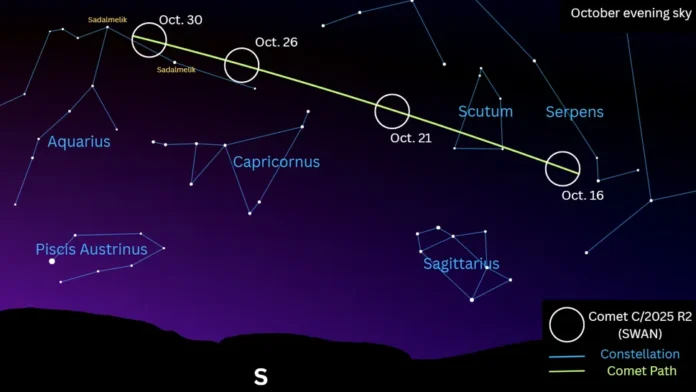
Key Takeaways
- Amateur discovery triumph: Comet SWAN (C/2025 R2) was spotted mid-September 2025 in NASA SOHO spacecraft data by a citizen scientist, continuing the pattern established by interstellar object 3I/ATLAS discovered through similar crowdsourced observation methods
- Peak viewing window: October 20–21, 2025, when the comet passes within 0.27 AU (approximately 40 million kilometers) of Earth—the closest approach for any significant comet since early 2025
- Rapid brightening: SWAN accelerated from telescope-only visibility to binocular-visible brightness within two weeks of discovery, with potential naked-eye visibility under dark-sky conditions during closest approach
LOS ALAMOS, CA – Comet C/2025 R2 (SWAN) was identified in mid-September 2025 by an amateur astronomer analyzing publicly available data from NASA’s Solar and Heliospheric Observatory (SOHO) spacecraft. The discovery echoes the detection methodology that brought interstellar object 3I/ATLAS to scientific attention—both objects were first flagged by non-professional astronomers combing through space agency datasets.
SWAN has demonstrated extraordinary brightening behavior as solar radiation vaporizes surface ice, creating a luminous coma and tail. Telescope observations have already captured the comet’s characteristic greenish gas tail, produced by diatomic carbon molecules fluorescing in sunlight.
The rapid brightening trajectory—from invisible to binocular-visible in roughly 14 days—suggests SWAN is a dynamically new comet making its first passage through the inner solar system, or a long-period visitor with highly volatile surface composition.
SWAN will make its closest approach to Earth on October 20–21, 2025, passing at a distance of 0.27 astronomical units—approximately 40 million kilometers or about 25 million miles. For context, this is roughly 105 times the distance between Earth and the Moon.
At closest approach, the comet’s brightness could reach naked-eye threshold under pristine dark-sky conditions, though most observers will achieve better views using binoculars or small telescopes. Light pollution in urban and suburban areas will likely require optical aid even during peak brightness.
The flyby distance places SWAN well outside any collision or gravitational-influence concern—the comet poses zero hazard to Earth, satellites, or space operations.


